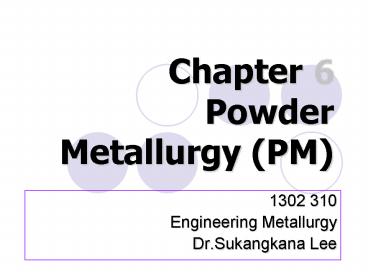Chapter 6 Powder Metallurgy (PM) - PowerPoint PPT Presentation
1 / 30
Title:
Chapter 6 Powder Metallurgy (PM)
Description:
??????????? ???????????????????????????????????? ????????????????????????????? ... SiO2 and Al2O3 cannot reduced during sintering leads to abrasive and tool wear ... – PowerPoint PPT presentation
Number of Views:712
Avg rating:3.0/5.0
Title: Chapter 6 Powder Metallurgy (PM)
1
Chapter 6Powder Metallurgy (PM)
- 1302 310
- Engineering Metallurgy
- Dr.Sukangkana Lee
2
Introduction
- ??????????? ????????????????????????????????????
??????????????????????????????????????????
??????????????????????????????????????????????????
????? - ???????????????????????????????????,
?????????????????????, ??????????????
??????????????????????????????
3
- ??????????????????????????????????????????????????
??????????? ? ???????????????????
????????????????????????? ???? bearings,
structural components and cutting tools ???? 60
?? - ????????????????????????????????? ??? ????????
- ???????????????????????????????????
- ???????????????????????????????
4
???????????????????????????????????????????? ?????
?????????????????? ???????????????????????????????
?????????
Material Tensile strength,MPa Tensileas Percent of Wrought Iron Tensile Elongationin 50 mm (2 in) Elongationas Percent of Wrought Iron Elongation
Wrought Iron, Hot Rolled 331 100 30 100
Powder Metal, 84 density 214 65 2 6
Powder Metal, repressed, 95 density 283 85 25 83
5
Benefits
- PM parts can be fabricated to final or near-net
shape, thereby eliminating or reducing scrap
metal, machining and assembly operation - Lower overall cost (less scrap lost)
- High melting point metals and composite materials
can be produced - PM is useful in making parts that have complex
shapes or difficult to machine - Permits a wide variety of alloy systems
- Produces good surface finishes
6
Benefits (Cont.)
- Provides materials which may be heat-treated for
increased strength or increased wear resistance - Provides controlled porosity for self-lubrication
or filtration - Facilitates manufacture of complex or unique
shapes which would be impractical or impossible
with other metalworking processes - Is suited to moderate- to high-volume component
production requirements - Offers long-term performance reliability in
critical applications - Is cost-effective
7
Disadvantages
- Porosity originates as the spaces between powder
particles ? low elongation - Expensive powder
8
Products and applications
9
(No Transcript)
10
(No Transcript)
11
Raw Materials
Mixing
Forming
Sintering
Optional Operations
12
Factors affected the QC of PM
- Powder characteristic Apparent density (AD), the
irregularity and porous texture decreases AD - Powder preparation most metal powder grains are
coated by a thin oxide film but will be broken up
during the pressing, stable oxide films e.g. SiO2
and Al2O3 cannot reduced during sintering leads
to abrasive and tool wear - Type of compacting press, tool and die
- Type of sintering furnace, atmosphere, time and
temperature - Heat treatment
13
5. Powder Manufacture
- PM Standards Fine powder particles lt 20 µm
- The finer the better preferably 2-10 µm
- Shape of Powders
- Sponge-like for iron powder gives good green
strength - Spheroidal particle gives high density and
uniform distribution (see Fig. 2)
14
(No Transcript)
15
Powder production
- There are four main processes
- Solid-state reduction
- Atomization
- Electrolysis
- Chemical
16
1. Solid state reduction
- Solid state reduction is the most widely used for
production of iron powder. - Process
- Selected ore is crushed and mixed with carbon
- Continuous furnace ? Sponge iron
- Further crushing
- Separation of non-metallic material
- Sieving? Irregular fine sponge-like powder
17
Milling
18
2. Atomization
- Atomization air, nitrogen, argon (for
oxidisable metal) and water are commonly used.
The particle shape is controlled by rate of
solidification of metal droplets. - Gas atomization gives spheroidal
- Water atomized gives a more irregular shape.
- Each powder produced by this method has the same
chemical composition.
19
GAS ATOMIZATION
Fine powder
Collection chamber
20
(No Transcript)
21
3. Electrolysis
- By choosing suitable conditions, such as
electrolyte composition and concentration,
temperature, and current density, many metals can
be deposited in a spongy or powdery state. - Further processingwashing, drying, reducing,
annealing, and crushingis often required,
ultimately yielding high-purity and high-density
powders.
22
- Copper is the primary metal produced by
electrolysis but iron, chromium, and magnesium
powders are also produced this way. - Due to its associated high energy costs,
electrolysis is generally limited to high-value
powders such as high-conductivity copper powders.
23
Electrolytic
24
4. Chemical process
- Use for production of a high purity, lt 5 ?m.
- The powders produced can have a great variation
in properties and yet have closely controlled
particle size and shape. - Oxide-reduced powders are often characterized as
spongy, due to pores present within individual
particles.
25
- Solution-precipitated powders can provide narrow
particle size distributions and high purity. - Thermal decomposition is most often used to
process carbonyls. These powders, once milled and
annealed, exceed 99.5 percent purity.
26
Sponge iron-reduced ore
27
Isostatic compaction
Vacuum melting and Cold forging
Hot isostatic pressing Plus hot forging
Direct hot isostatic pressing
28
Sinter-HIP
- Sintered metals 92 density is sufficient to
ensure that open porosity at surface has been
eliminated ? HIPed to full density. - This process start from sintering then high
pressure argon is introduced or vacuum sinter
followed by HIPing in a separate apparatus for
hard metal cutting tools.
29
(No Transcript)
30
Metal injection Moulding (MIM)
Powder Binder
Blending
Granulation
Injection Moulding
Green body
Debinding
Brown body
Sintering
99 Density
Finished part































